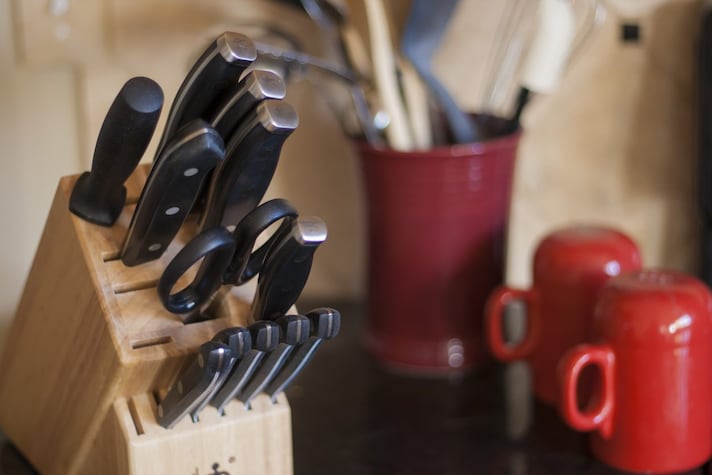
Keeping your knife block clean is a fundamental aspect of kitchen hygiene: this often overlooked accessory can become an ideal environment for the proliferation of bacteria and mold due to the accumulation of food residue and humidity. Regular cleaning not only prevents food contamination, but also helps maintain the functionality and appearance of the block itself. The ideal frequency for cleaning is about once a month, but this may vary based on use and knife storage habits.
How to Clean Knife Holders
Cleaning the knife block is not a very simple operation, but with a few precautions you can do it in a practical and effective way. Proceed as follows:
- Removing knives. Start by removing all knives from the block and placing them in a safe place.
- Removing surface debris. Use the narrow nozzle of a vacuum cleaner to thoroughly vacuum the inside of each crevice, removing crumbs and dust.
- External cleaning. Clean the outside surface of the log with a microfiber cloth slightly dampened with water and a mild dish detergent.
- Cleaning the inside of the crevices. Make a solution of warm water with a few drops of mild dish soap: use a bottle brush with thin bristles to scrub the inside of each crevice, focusing on removing any caked-on residue. Alternatively, you can make a solution with white vinegar and water: use the brush or a clean cloth soaked in this solution to clean the inside of each crevice, taking advantage of the antibacterial properties of the vinegar.
- Removing residue. Wipe the outside surface of the log with a clean cloth dampened with water only to remove any traces of detergent or vinegar.
- Dry thoroughly. Allow the block to air dry completely before reinserting the knives: make sure the inside of the slots is completely dry to prevent mold.
Precautions for A Wooden Knife Block
Compared to hard plastic or metal, the wooden block is much more attractive: at the same time, however, it is also more delicate. To clean it, remember to avoid soaking it: slightly dampen the cloth to clean the outside and dry immediately afterwards with a dry cloth. Use very little warm water with a minimal amount of delicate detergent to clean the inside of the cracks. The brush should only be damp, not soaked. If you use vinegar to clean the cracks, dilute it with more water (e.g. 3 parts water and 1 part vinegar) to make it less aggressive on the wood.
Also make sure that the wooden block air dries completely after cleaning, possibly for a longer period and in a well-ventilated place. Finally, periodically apply a food-grade oil to the entire surface of the wood (inside cracks if possible) to moisturize it, prevent dryness and cracks, and protect it from humidity: let it absorb and then remove the excess. Never immerse the wooden block in water and never wash it in the dishwasher.

General Advice
Some tips to extend the life of your knife holder:
- Always store knives completely clean and dry in the block.
- Use bottle brushes or special pipe cleaners to reach inside the cracks.
- Opt for gentle dish detergents or white vinegar-based solutions: avoid using abrasive sponges that could damage the material of the log.
- For wooden logs, consider periodically applying cooking oil to preserve their integrity.
;Resize,width=767;)
